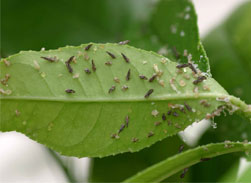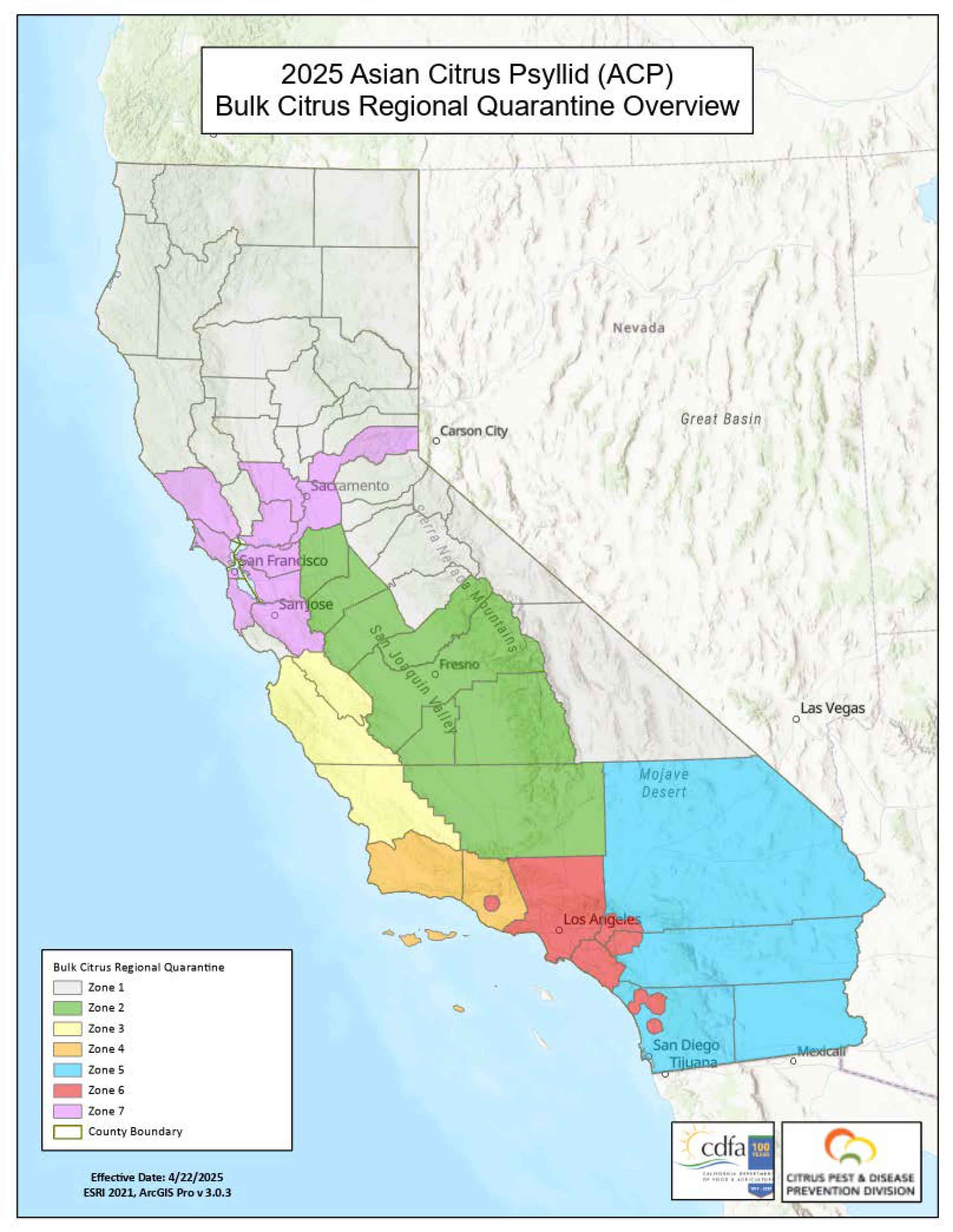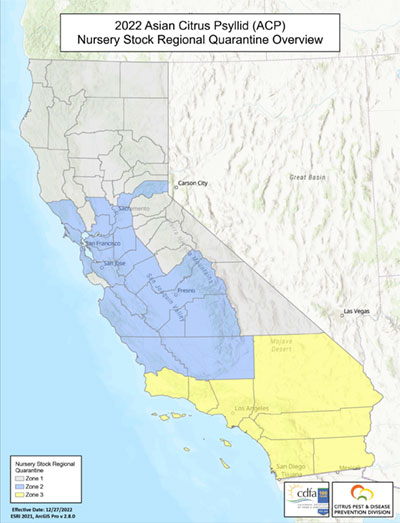Asian Citrus Psyllid (ACP)
Regulation and Quarantine Boundaries

The Asian citrus psyllid (ACP) is a pest that acts as a carrier or vector spreading huanglongbing (HLB), a devastating disease of citrus trees. This bacterial disease is transmitted to healthy trees by the psyllid after it feeds on infected plant tissue.
Quarantine Information
Regional Quarantine Zone
- Active Regional Quarantines Web Application - 12/05/25
- Maps: See Regional Quarantine Zones in sections below:
-
Bulk Citrus Regional Quarantine Zones
Google Earth File (.kmz)
-
Nursery Regional Quarantine Zones
Google Earth File (.kmz)
Bulk Citrus Regional Quarantine Zones
Zones and Counties
Zone 1
Comprises uninfested counties where HLB has not been detected, there are no contiguous citrus growing regions, and it is not proximate to the border with Mexico.
- Zone 1 Counties: Alpine, Amador, Butte, Calaveras, Colusa, Del Norte, El Dorado, Glenn, Humboldt, Inyo, Lake, Lassen, Mariposa, Mendocino, Modoc, Mono, Napa, Nevada, Plumas, Santa Cruz, Shasta, Sierra, Siskiyou, Sutter, Tehama, Trinity, Tuolumne, and Yuba.
Zone 2
Comprises counties that are partially infested with ACP, HLB has not been detected, a geographical barrier exists between it and adjacent contiguous citrus growing regions (i.e., Zones 4, 5, and 6), a contiguous citrus growing region exists within the zone, sufficient citrus commodity cleaning and packing capacity exists within the zone, and geographical barriers separate it from zones that are heavily infested with ACP and where HLB has been detected (i.e., Zone 6).
- Zone 2 Counties: Fresno, Kern, Kings, Madera, Merced, San Joaquin, Stanislaus, and Tulare
Zone 3
Comprises counties that are partially infested with ACP, HLB has not been detected, a geographical barrier exists between it and adjacent contiguous citrus growing regions (i.e., Zone 2, 3, and 4), a contiguous citrus growing region exists within the zone, sufficient citrus commodity cleaning and packing capacity exists within the zone, and geographical barriers separate it from zones that are heavily infested with ACP (i.e., Zone 4) or where HLB has been detected (i.e., Zone 6).
- Zone 3 Counties: Monterey, San Benito, and San Luis Obispo
Zone 4
Comprises counties that are generally infested with ACP, HLB has not been detected, a geographical barrier exists between it and adjacent contiguous citrus growing regions (i.e., Zones 2, 3, and 4), a contiguous citrus growing region exists within the zone, sufficient citrus commodity cleaning and packing capacity exists within 8 the zone, geographical barriers separate it from Zone 6 where HLB has been detected, and it is not proximate to the border with Mexico.
- Zone 4 Counties: Santa Barbara and Ventura
Zone 5
Comprises counties that are generally infested with ACP, HLB has not been detected, a geographical barrier exists between it and adjacent contiguous citrus growing regions (i.e., Zones 4 and 6), a contiguous citrus growing region exists within the zone, sufficient citrus commodity cleaning and packing capacity exists within the zone, a geographical barrier separates it from Zone 6 where HLB has been detected, and it is proximate to the border with Mexico.
- Zone 5 Counties: Imperial and San Diego Counties, and a Portion of Riverside and San Bernardino Counties
Zone 6
Comprises counties, or portions of counties, that are generally infested with ACP, HLB has been detected in some areas, a geographical barrier exists between it and adjacent contiguous citrus growing regions (i.e., Zones 2, 4, and 5), a contiguous citrus growing region exists within the zone, sufficient citrus commodity cleaning and packing capacity exists within the zone, and it is not proximate to the border with Mexico.
- Zone 6 Counties: Los Angeles and Orange counties and Portions of Riverside, San Bernardino, San Diego and Ventura counties as described in the "ACP Bulk Citrus Zone 6 - Text Description" above.
Zone 7
Comprises counties that are partially infested with ACP, HLB has not been detected, there are no contiguous citrus growing regions, and it is not proximate to the border with Mexico.
- Zone 7 Counties: Alameda, Contra Costa, Marin, Placer, Sacramento, Santa Clara, San Francisco, San Mateo, Solano, Sonoma, and Yolo Counties
Host Nursery Stock Regional Quarantine Zones
Zones and Counties
Zone 1
Comprises uninfested counties, geographical barriers exist between it and Zone 3, and it is not proximate to the border with Mexico.
- Zone 1 Counties: Alpine, Amador, Butte, Calaveras, Colusa, Del Norte, El Dorado, Glenn, Humboldt, Inyo, Lake, Lassen, Mariposa, Mendocino, Modoc, Mono, Napa, Nevada, Plumas, Santa Cruz, Shasta, Sierra, Siskiyou, Sutter, Tehama, Trinity, Tuolumne and Yuba
Zone 2
Comprises counties that are partially infested with ACP, geographical barriers exist between it and Zone 3, HLB has not been detected, and the zone is not proximate to the border with Mexico.
- Zone 2 Counties: Alameda, Contra Costa, Fresno, Kern, Kings, Madera, Marin, Merced, Monterey, Placer, Sacramento, San Benito, San Francisco, San Joaquin, San Luis Obispo, San Mateo, Santa Clara, Solano, Sonoma, Stanislaus, Tulare, and Yolo
Zone 3
Comprises counties that are generally infested with ACP, HLB has been detected in some areas, and the zone is proximate to the border with Mexico.
- Zone 3 Counties: Imperial, Los Angeles, Orange, Riverside, San Bernardino, San Diego, Santa Barbara, and Ventura
Instructions on Appeal Process
Any interested party or local entity may appeal the designation of a county or portion thereof into a regional quarantine zone by submission to the Department of a written request for review of the designation accompanied by clear and convincing evidence justifying a change in the designation.
The appeal must be filed no later than ten (10) working days following receipt of the notice of designation. The Department must respond with a written decision no later than ten (10) working days following receipt of the appeal. During the pending of the appeal, the designation under appeal shall remain in effect.


